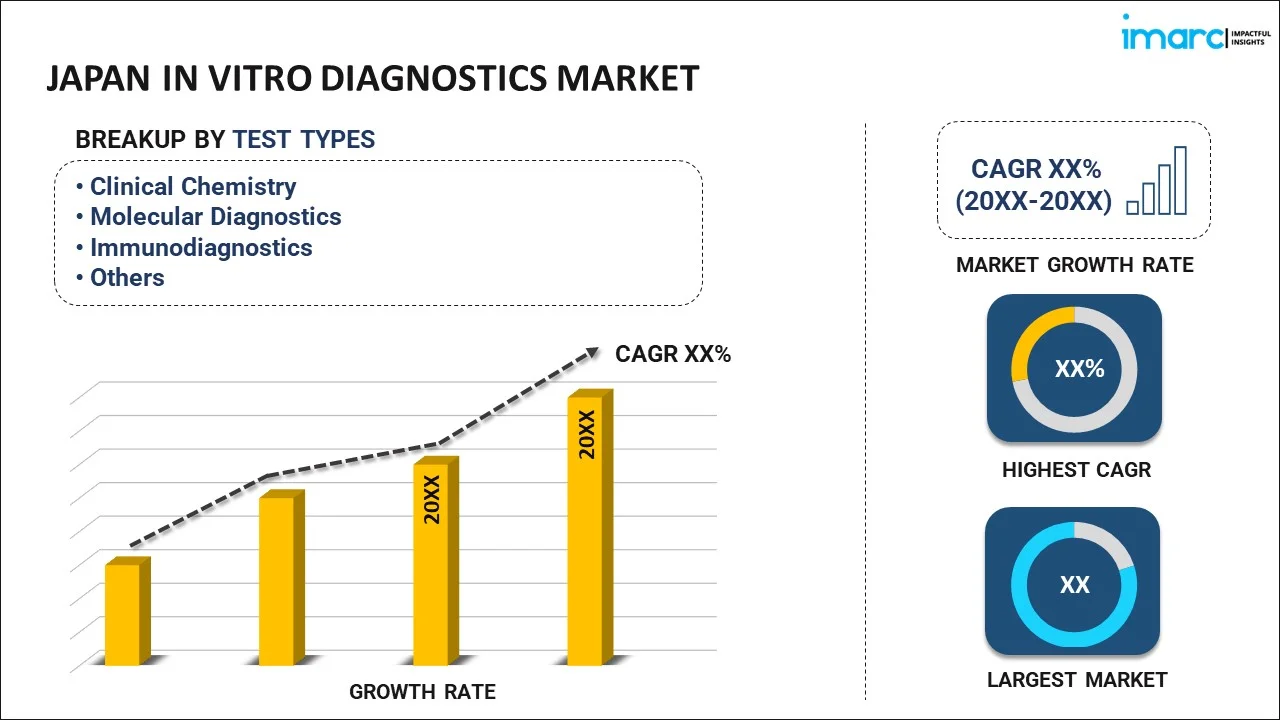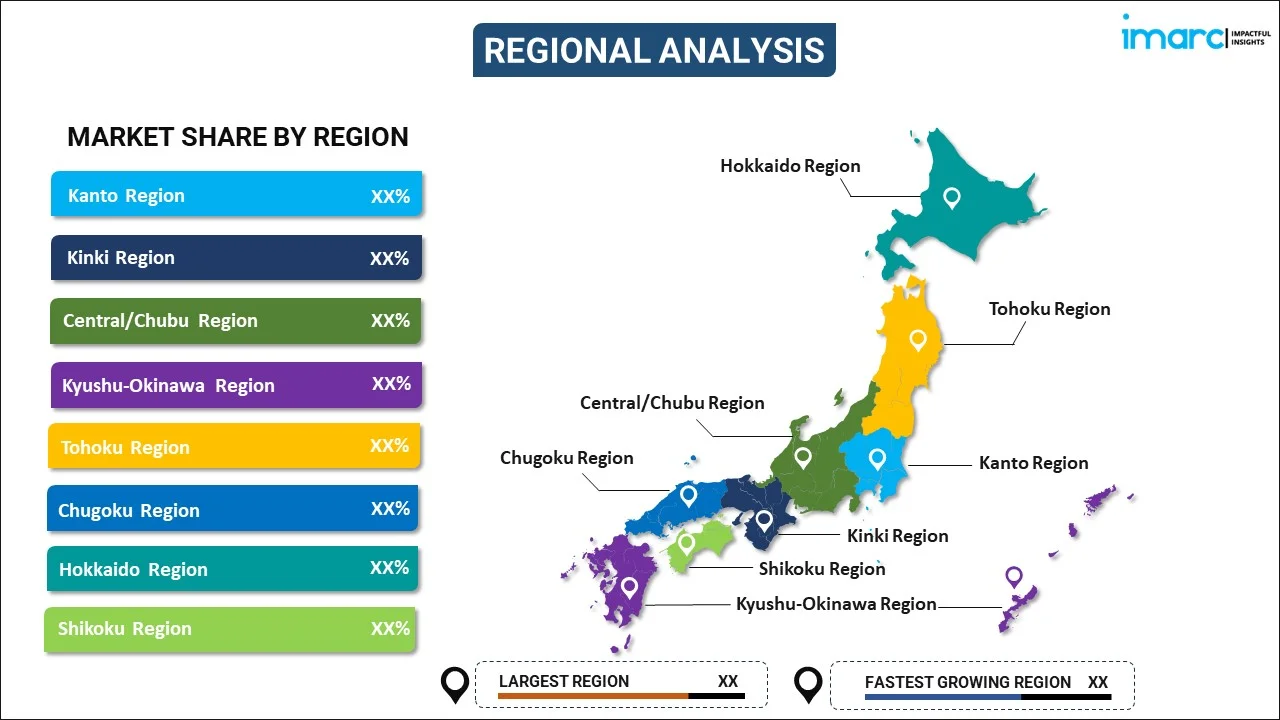
Japan In Vitro Diagnostics Market Report by Test Type (Clinical Chemistry, Molecular Diagnostics, Immunodiagnostics, Hematology, and Others), Product (Reagents and Kits, Instruments), Usability (Disposable IVD Devices, Reusable IVD Devices), Application (Infectious Disease, Diabetes, Cancer/Oncology, Cardiology, Autoimmune Disease, Nephrology, and Others), End User (Hospitals Laboratories, Clinical Laboratories, Point-Of-Care Testing Centers, Academic Institutes, Patients, and Others), and Region 2025-2033
Market Overview:
The Japan in vitro diagnostics market size reached USD 5.0 Billion in 2024. Looking forward, IMARC Group expects the market to reach USD 6.21 Billion by 2033, exhibiting a growth rate (CAGR) of 2.4% during 2025-2033. The rising geriatric population, rapid technological advancements, growing healthcare awareness, increasing government initiatives, development of personalized medication, enhanced focus on research and development (R&D) activities represent some of the key factors driving the market.
|
Report Attribute
|
Key Statistics
|
|---|---|
|
Base Year
|
2024 |
|
Forecast Years
|
2025-2033 |
|
Historical Years
|
2019-2024
|
| Market Size in 2024 | USD 5.0 Billion |
| Market Forecast in 2033 | USD 6.21 Billion |
| Market Growth Rate (2025-2033) | 2.4% |
In vitro diagnostics (IVD) is a collection of medical tests performed using biological samples from the human body. These tests detect diseases, infections, and other medical conditions by analyzing blood, urine, or tissue samples outside the living organism. They are utilized in laboratories, hospitals, and specialized clinics and are vital in medical decision-making, patient monitoring, and personalized treatment. The increasing adoption of IVD in healthcare supports early diagnosis and precise treatment, allowing healthcare providers to make informed and timely decisions. As an essential component of modern healthcare systems, IVD contributes to the advancement of preventive and therapeutic care, enhancing overall patient well-being. It also improves healthcare efficiency, promoting early detection and reducing healthcare costs. It is also employed in monitoring chronic illnesses and assisting in therapeutic decision-making.
Japan In Vitro Diagnostics Market Trends:
The rising geriatric population necessitating more comprehensive and routine medical testing is one of the major factors contributing to the market growth. In line with this, the increasing prevalence of age-related diseases, such as diabetes, cardiovascular conditions, and cancer, prompting increased IVD tests to diagnose and manage these ailments, is propelling the market growth. Additionally, rapid technological advancements in IVD that are introducing innovative solutions with higher accuracy and efficiency, such as innovations in molecular diagnostics, point-of-care (POC) testing, and automation technologies, enhancing the precision, speed, and accessibility of IVD tests, are also creating a positive outlook for the market growth. In addition to this, the increasing government initiatives promoting healthcare innovation and the introduction of user-friendly, personalized IVD solutions are also positively impacting the market growth. Moreover, the growing awareness and emphasis on preventive healthcare as consumers are increasingly proactive in managing their health, leading to higher demand for wellness-related diagnostic tests and personalized medicine solutions, is acting as a growth-inducing factor. Furthermore, the sudden shift towards personalized medicine and the development of molecular diagnostics are shaping the future of the IVD market in Japan. Besides this, the increasing focus on research and development (R&D) and partnerships between diagnostics companies and research institutions are providing remunerative growth opportunities for the market. In addition to this, the integration of big data and artificial intelligence (AI) in diagnostics, enhancing analytical capabilities, and personalizing care is providing remunerative opportunities for the market growth.
Japan In Vitro Diagnostics Market Segmentation:
IMARC Group provides an analysis of the key trends in each segment of the Japan in vitro diagnostics market report, along with forecasts at the country level for 2025-2033. Our report has categorized the market based on test type, product, usability, application and end user.
Test Type Insights:

- Clinical Chemistry
- Molecular Diagnostics
- Immunodiagnostics
- Hematology
- Others
The report has provided a detailed breakup and analysis of the market based on the test type. This includes clinical chemistry, molecular diagnostics, immunodiagnostics, hematology, and others.
Product Insights:
- Reagents and Kits
- Instruments
The report has provided a detailed breakup and analysis of the market based on the product. This includes reagents and kits and instruments.
Usability Insights:
- Disposable IVD Devices
- Reusable IVD Devices
The report has provided a detailed breakup and analysis of the market based on the usability. This includes disposable IVD devices and reusable IVD devices.
Application Insights:
- Infectious Disease
- Diabetes
- Cancer/Oncology
- Cardiology
- Autoimmune Disease
- Nephrology
- Others
A detailed breakup and analysis of the market based on the application has also been provided in the report. This includes infectious disease, diabetes, cancer/oncology, cardiology, autoimmune disease, nephrology, and others.
End User Insights:
- Hospitals Laboratories
- Clinical Laboratories
- Point-Of-Care Testing Centers
- Academic Institutes
- Patients
- Others
The report has provided a detailed breakup and analysis of the market based on the end user. This includes hospitals laboratories, clinical laboratories, point-of-care testing centers, academic institutes, patients and others.
Regional Insights:

- Kanto Region
- Kinki Region
- Central/ Chubu Region
- Kyushu-Okinawa Region
- Tohoku Region
- Chugoku Region
- Hokkaido Region
- Shikoku Region
The report has also provided a comprehensive analysis of all the major regional markets, which include the Kanto Region, Kinki Region, Central/ Chubu Region, Kyushu-Okinawa Region, Tohoku Region, Chugoku Region, Hokkaido Region and Shikoku Region.
Competitive Landscape:
The report has also provided a comprehensive analysis of the competitive landscape in the market. Competitive analysis such as market structure, key player positioning, top winning strategies, competitive dashboard, and company evaluation quadrant has been covered in the report. Also, detailed profiles of all major companies have been provided.
Japan In Vitro Diagnostics Market Report Coverage:
| Report Features | Details |
|---|---|
| Base Year of the Analysis | 2024 |
| Historical Period | 2019-2024 |
| Forecast Period | 2025-2033 |
| Units | Billion USD |
| Scope of the Report | Exploration of Historical and Forecast Trends, Industry Catalysts and Challenges, Segment-Wise Historical and Predictive Market Assessment:
|
| Test Types Covered | Clinical Chemistry, Molecular Diagnostics, Immunodiagnostics, Hematology, Others |
| Products Covered | Reagents and Kits, Instruments |
| Usabilities Covered | Disposable IVD Devices, Reusable IVD Devices |
| Applications Covered | Infectious Disease, Diabetes, Cancer/Oncology, Cardiology, Autoimmune Disease, Nephrology, Others |
| End Users Covered | Hospitals Laboratories, Clinical Laboratories, Point-of-care Testing Centers, Academic Institutes, Patients, Others |
| Regions Covered | Kanto Region, Kinki Region, Central/ Chubu Region, Kyushu-Okinawa Region, Tohoku Region, Chugoku Region, Hokkaido Region, Shikoku Region |
| Customization Scope | 10% Free Customization |
| Post-Sale Analyst Support | 10-12 Weeks |
| Delivery Format | PDF and Excel through Email (We can also provide the editable version of the report in PPT/Word format on special request) |
Key Questions Answered in This Report:
- How has the Japan in vitro diagnostics market performed so far and how will it perform in the coming years?
- What has been the impact of COVID-19 on the Japan in vitro diagnostics market?
- What is the breakup of the Japan in vitro diagnostics market on the basis of test type?
- What is the breakup of the Japan in vitro diagnostics market on the basis of product?
- What is the breakup of the Japan in vitro diagnostics market on the basis of usability?
- What is the breakup of the Japan in vitro diagnostics market on the basis of application?
- What is the breakup of the Japan in vitro diagnostics market on the basis of end user?
- What are the various stages in the value chain of the Japan in vitro diagnostics market?
- What are the key driving factors and challenges in the Japan in vitro diagnostics market?
- What is the structure of the Japan in vitro diagnostics market and who are the key players?
- What is the degree of competition in the Japan in vitro diagnostics market?
Key Benefits for Stakeholders:
- IMARC’s report offers a comprehensive quantitative analysis of various market segments, historical and current market trends, market forecasts, and dynamics of the Japan in vitro diagnostics market from 2019-2033.
- The research study provides the latest information on the market drivers, challenges, and opportunities in the Japan in vitro diagnostics market.
- Porter's five forces analysis assist stakeholders in assessing the impact of new entrants, competitive rivalry, supplier power, buyer power, and the threat of substitution. It helps stakeholders to analyze the level of competition within the Japan in vitro diagnostics industry and its attractiveness.
- Competitive landscape allows stakeholders to understand their competitive environment and provides an insight into the current positions of key players in the market.
Need more help?
- Speak to our experienced analysts for insights on the current market scenarios.
- Include additional segments and countries to customize the report as per your requirement.
- Gain an unparalleled competitive advantage in your domain by understanding how to utilize the report and positively impacting your operations and revenue.
- For further assistance, please connect with our analysts.
 Inquire Before Buying
Inquire Before Buying
 Speak to an Analyst
Speak to an Analyst
 Request Brochure
Request Brochure
 Request Customization
Request Customization




.webp)




.webp)












